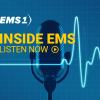Download this week’s episode on iTunes, SoundCloud or via RSS feed
In this week’s Inside EMS Podcast, co-hosts Chris Cebollero and Kelly Grayson discuss patients experiencing excited delirium, and whether administering a benzodiazepine is the best treatment option.
“I think benzo’s are a singularly poor choice for sedation and chemical restrain in excited delirium,” Grayson said. But the reality is that for many departments, it’s the only choice.
Cebollero said excited delirium has been mismanaged by EMS for years.
“There’s not enough research that goes into what we use in the field that’s been successful,” he said. “And we just kind of use the same old, same old, because it’s word of mouth.”
Cebollero points out that using Versed through a nasal atomizer has proven successful (though potentially difficult to administer to an excited delirium patient), and Grayson suggests Ketamine as another effective medication.
“Why we’re not using it in greater degree, I don’t know,” he said.
One of the biggest problems is that there doesn’t seem to be a consensus in EMS as to how to treat excited delirium; it’s managed differently across EMS systems. However, benzodiazepines are better than no drug, Grayson said.
“Even the benzo’s are far better than physical restraint,” Grayson said. “The goal is to stop the fight, and the fight is not over when you have the patient strapped to the stretcher.”
In the News
In this week’s news, Cebollero and Grayson discuss a patient who sued FDNY, claiming EMS providers lifted her into an ambulance instead of using a stretcher, and caused a gash to her leg that required 21 stitches. The lawsuit states EMTs told her they weren’t able to lower the steps to carry her into the ambulance because they were “unserviceable.”
“We really have to be able to make sure we’re keeping that person safe,” Cebollero said. “If they fall and they get hurt, it’s our responsibility.”
Grayson, however, said it’s not feasible to bring a stretcher into the house on every call, and it’s often easier to pick a patient up and carry them to the unit.
“That’s the problem when you let your EMTs and medics use their judgment in that regard,” Grayson said. “Inevitably someone practices bad judgment, and it burns everyone.”
They also talked about declining EMS staff in Texas, with Austin experiencing a record number of employee separations, and how it ties into rural Wisconsin’s struggles with a volunteer EMT shortage.
Cebollero and Grayson agree that EMT shortages are a nation-wide problem, but Grayson points out that volunteerism is at an all-time in the U.S. and wonders why EMS is not cashing in on it.
“It’s not so much that it’s hard to find volunteers,” Grayson said. “We’re looking in the wrong places, and recruiting the wrong people for the wrong reasons.”
They also discuss a medic who initially reported to police that he was stabbed by an attacker at an ambulance station, and it was later discovered that his wounds were self-inflicted. He cut himself and it was deeper than he intended, so he fabricated story, according to the reports.
Cebelleero said he was surprised at many of the online comments essentially cheering that the medic has been relieved of his positon, and said it’s pointing a finger rather than fixing the problem.
“They’re really kind of damning toward the individual that hurt himself,” Cebollero said. “I contend … is this a cry for help? Is this stress getting to this individual?”












